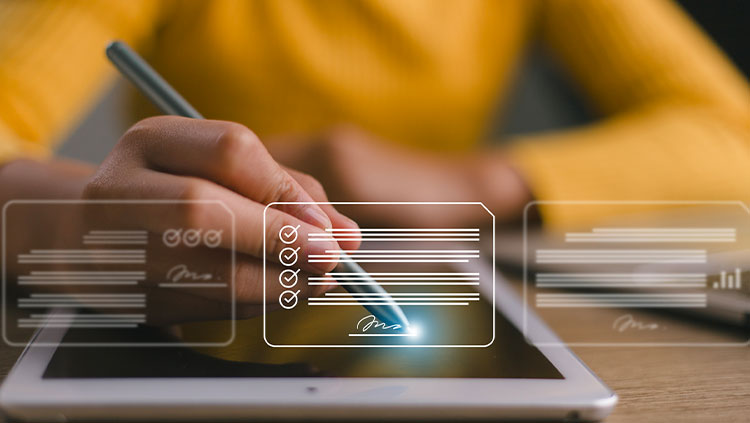Sign on the dotted line: how digital identification systems work
Content Summary
- Technology
- Public practice

This article was current at the time of publication.
When mandatory client verification requirements for tax professionals were introduced in late 2022, Liz Moore FCPA began exploring digital solutions for compliance.
The CEO of Melbourne-based practice Bluebird Accounting says manual processes were a cumbersome and inconvenient way for clients to prove their identity.
“We would have to get on to a Zoom or a Teams meeting, sight the ID and the client and verify their details that way, or they would have to come into the office, and we would verify their ID,” says Moore.
In August 2023, Bluebird Accounting began using Annature, an electronic signing and ID verification platform built for accountants to comply with the Tax Practitioners Board guidelines for proof of identity.
“It gives us that peace of mind that the team is following protocol, the practice is within quality control and we’re meeting those requirements,” says Moore.
Identity goes digital
A digital identity is a secure way to prove who you are online. It can be created through platforms like myGovID, using Australian identity documents like your driver's licence and passport, or through a proprietary system.
In November 2023, the Federal Government introduced the Digital ID Bill 2023 (Cth) and the Digital ID (Transitional and Consequential Provisions) Bill 2023 (Digital ID Bills), which provide rules for an expansion of Australia’s system of digital identification.
Malcolm Burrows, Legal Practice Director at Dundas Lawyers, says the key aim of the two Bills is to establish an accreditation scheme for providers of digital ID services.
“Mechanisms like the Digital ID Bill simply lessen the likelihood of anything going wrong in terms of dealing with somebody other than the intended recipient,” he says.
“It is just another layer of making sure that businesses are dealing with the right people.
“It also includes some measures to extend privacy protection for individuals, because there’s new digital attributes and biometric information, for example,” says Burrows, adding that a digital ID regulator will have powers to implement provisions that relate to accreditation.
“It can remove accreditation, but it is a little bit unclear as to what the effect of removing accreditation would be.”
Building trust with clients
Digital ID systems are designed to protect the sensitive personal information of users, but Moore says they also help in building relationships with new clients.
“When we're building the client connection and relationship at the start, it can feel intrusive to say to the client, ‘look, can I please see your ID because I want to know that you are who you say you are’,” she says.
“As much as we need to do that, we also want to give clients the experience that they can build that trusted adviser relationship. By having a digital identity verification platform, we can send that through to their mobile phone and their email address prior to meeting with them for the first time.”
Moore adds that digital ID verification can also be a time saver for accountants.
“If there is something that doesn't look right or is not able to be verified, we are then saving time, because we can say to the client that we need to make some additional checks,” she says.
“And in the event [that] they are not who they say they are, we have reduced our risk of meeting with them.”
Managing the risks
While digital IDs and e-signatures can improve efficiency in public practices, Burrows says practitioners should be aware of the risks of dealing with people in a purely digital space.
“Right now, if you're using a digital signing service, how do you really know that the person who signed it is actually the intended recipient, unless you saw them sign it?
“I suppose it’s a common-sense thing,” adds Burrows. “If you’ve wholly transacted with someone electronically, you should at least talk to them at some point.”
Direct contact with new clients is part of the risk-management process at Bluebird Accounting, says Moore.
“With existing clients that we have verified and have an ongoing long-term relationship with, we obviously know that that's their email address and they are who they say they are. However, if they were to send us an email saying, I've changed my email address, we will always give them a call to confirm it.
“Protecting our practices and clients against cyber risk is one of our biggest challenges in the current environment,” adds Moore. “Finding solutions that meet your practice needs, your integrity measures and the current software stack that you’re using is really important.”
Moore encourages other public practitioners to “be curious” about adopting recent technologies like digital IDs and electronic signatures.
“Ask questions, ask network colleagues and other practitioners about what works for them,” she says. “Also, look at the long-term benefits of protecting your practice and your clients.”
Stat decs go digital
Commonwealth statutory declarations went digital in February this year, allowing Australians to use myGov and their digital identity in place of a witness. The myGov platform is currently the only approved online platform that can create a digital statutory declaration.
Digital stat decs will have a QR code, which is encrypted with the information provided in the declaration. To verify the authenticity of the declaration, anyone with a paper or digital copy of the declaration can scan the QR code with the myGov app. The text and details on the QR code page can then be compared with the declaration received.
If you don’t have a myGov account with a digital identity connected to it, you can still make a stat dec using a witness in person or remotely over video link.
Discover more
Cyber security breach shines spotlight on data protection
Recent data breaches show up weaknesses in New Zealand businesses’ privacy protection
- Public practice
- Technology
- Data management
article·Published onDo you have the right advisory tools?
You may already have the software you need to build your advisory business
- Technology
- Public practice
article·Published on6 tips for using electronic signatures
E-signatures can be used to witness some documents. Here’s what the law says.
- Technology
- Public practice
article·Published on6 tips for using electronic signatures
Legal experts weigh in on witnessing documents using e-signatures. Here’s what you need to know.
- Technology
- Public practice
article·Published onProfessional indemnity insurance claims: cyber risk
11 December 2020 | Join our experts as they share real-life claims
- Public practice
- Technology
Published on39 min read timeTechnology and cybersecurity
Technology improves business efficiency, cuts costs, improves service delivery and maximises profitability
- Technology


